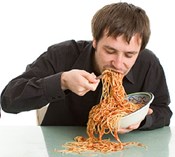Many of us, no matter how hard we try, have a hard time adjusting what we eat to what we need. We eat when we’re not hungry, we eat more than we need, and we don’t stop eating when we get full. The result of that lack of adjustments shows up on our hips. Ouch!
But with all the years of trying, it is obvious that just wanting to adjust, willing to adjust, trying to adjust, is not enough! Since so many people are so interested in the topic, it stands to reason that others are trying to figure out why we don’t adjust, and what we can do make the adjustment less painful. There is lots of evidence, and more on the way, that eating too much is not just a problem of lack of will-power. There are hormones, enzymes and other chemical differences that put a lot of pressure on how much we eat.
But we are also learning more about how to get around those pressures. Recent research has found a lot of reliable ways to help us adjust our eating. You might recognize that some of these methods have been turned into popular diet books. Most books have at least a kernel of science in them. But the truth for most of us is that we need more than just one tactic. So use as many of these different methods as you can. The more ways you tackle the problem, the more likely it is to tumble. And that means the more likely you’ll get rid of some of the hips.
Pay attention to what makes you feel full. Some people get full faster with protein, others with carbohydrate. If you need carbs to feel satisfied, then a high protein diet will always leave you feeling hungry. Give yourself a little of what you need to feel full and you’ll eat less of everything else.
Pay attention to what makes you feel satisfied. Some people find that fats are what make them happy. Others need sugar. If you need fat, then a little bit of that will let you be happy and stop eating sooner.
Look at how big your plate of food is. We usually eat about the same amount of food, whether it has lots of calories or just a few. So fill up your space with foods full of water and fiber (fruits, veggies and whole grains) instead of fat and sugar. You’re more likely to be satisfied with fewer calories.
Do you eat with your eyes? Most of us fill a plate and eat it all, whether it’s a big plate or a little one. People who ate from a soup bowl that automatically stayed full ate almost twice as much without feeling too full. They didn’t pay attention to how much they were eating. The bowl looked full, so they kept eating! So use smaller plates.
Pay attention to your food. The more distractions you have going on around you - TV, computer, reading - the longer you are likely to keep eating. It’s harder to realize that you’re feeling full when your attention is on something else.
Keep it simple. How many people stop at one plate in an all-you-can-eat buffet? The bigger variety of food you have to choose from, the more you are likely to eat. You can certainly eat different kinds of foods, but don’t try to have them all at the same meal. We ‘can always find room for dessert’ because the sweet is different from the salty meats and vegetables.
Think about how you feel. Not just that you feel hungry, but are you angry, stressed, worried, sad? Many of us were taught as infants that a bottle was the solution every time we cried, whether we cried because of a wet diaper, a bright light, we were lonely or we were hungry. Now we eat whenever something is wrong. Try to be aware of how you’re feeling, and decide if it’s really hunger. If it is, eat. If not, find something else to do.
Here’s a quick refreshing salad that’s also bright and colorful. It will fill up your plate without too many calories, satisfy your eyes and has enough fat to keep most of us happy. If you have leftover fresh corn from the cob, either boiled or roasted, you’ll need about 3 ears. Otherwise, use frozen or even canned. Enjoy in good health!
Limey Corn and Tomato Salad
1 ½ cups corn kernels 1 small red onion
5 cups arugula or spinach leaves 8 cherry tomatoes, halved
1/4 cup fresh cilantro, chopped 2 tablespoons fresh lime juice
4 tablespoons olive oil 1/4 teaspoon pepper, salt to taste
Chop the onion, wash and pat dry the greens. Combine corn, greens, onion, tomato and cilantro in large bowl. Stir remaining ingredients together with a fork until well mixed. Pour over salad and toss. To prepare in advance, combine as directed except for the greens. Refrigerate salad and greens, then add greens just before serving. Serves 4.







